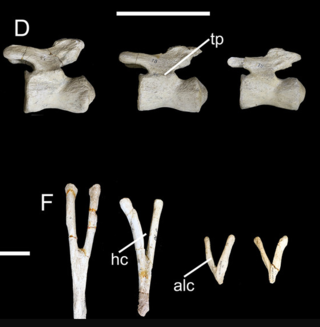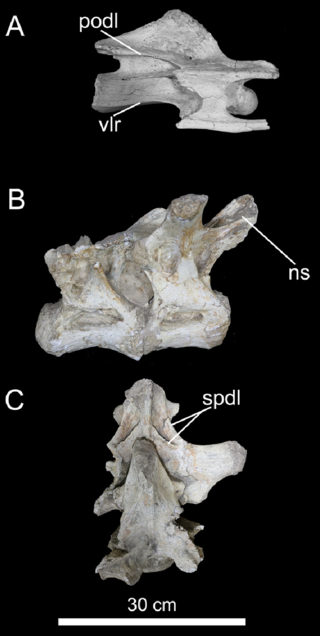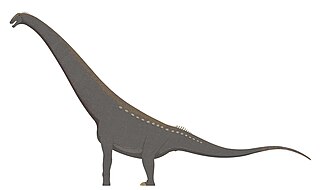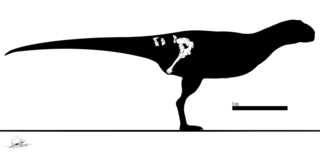
Aeolosaurus is a genus of titanosaurian sauropod dinosaur from the Late Cretaceous Period of what is now South America. Like most sauropods, it would have been a quadrupedal herbivore with a long neck and tail. Aeolosaurus is well known for a titanosaur, as it is represented by the remains of several individuals belonging to at least two species. However, like most titanosaurs, no remains of the skull are known. The holotype of Aeolosaurus rionegrinus consists of a series of seven tail vertebrae, as well as parts of both forelimbs and the right hindlimb. It was discovered in the Angostura Colorada Formation in Argentina, which dates from the Campanian stage of the Late Cretaceous, about 83 to 74 million years ago. The species A. maximus was transferred over to the new genus Arrudatitan in 2021.

Adamantisaurus is a poorly-known genus of titanosaurian sauropod dinosaur from the Late Cretaceous Period of what is now South America. It is only known from six tail vertebrae but, as a sauropod, it can be assumed that this dinosaur was a very large animal with a long neck and tail.

Baurutitan is a genus of sauropod dinosaur that lived during the Late Cretaceous in what is now Brazil. The type species, Baurutitan britoi, was described in 2005 by Kellner and colleagues, although the fossil remains had already been discovered in 1957. Baurutitan is classified as a lithostrotian titanosaur, and is distinguished from related genera based on its distinctive caudal vertebrae. This South American dinosaur was found in the Serra da Galga Formation near Uberaba, in the Brazilian state of Minas Gerais.

Trigonosaurus, is a genus of saltasaurid dinosaurs from the Maastrichtian Serra da Galga Formation of Brazil. The type species, Trigonosaurus pricei, was first described by Campos, Kellner, Bertini, and Santucci in 2005. It was based on two specimens, both consisting mainly of vertebrae. The two specimens were originally believed to have come from the same individual. However, one specimen was described as the holotype of Caieiria in 2022, while the holotype may have instead come from Baurutitan. Before its description, it was known as the "Peirópolis titanosaur", after the place it was found.

Pellegrinisaurus is a genus of titanosaurian sauropod dinosaur that lived in South America during the Late Cretaceous period. The holotype was found in the Allen Formation, Argentina.

Maxakalisaurus is a genus of titanosaur dinosaur, found in the Adamantina Formation of Brazil, in the state of Minas Gerais in 1998. The genus name is derived from the tribe of the Maxakali; Topa is one of their divinities.

Uberabatitan is a genus of titanosaurian sauropod dinosaur from the Late Cretaceous of Brazil. It is known from bones including neck, back, and tail vertebrae, pelvic bones, and limb bones. These fossils were found in the uppermost portion of the Maastrichtian-age Serra da Galga Formation of the Bauru Group, in Uberaba, Minas Gerais. The type species, described by Salgado and Carvalho in 2008, is U. ribeiroi. To date, it is the most recent titanosaur from Bauru Group rocks; other titanosaurs from the Bauru Group, including Baurutitan and Trigonosaurus, come from lower levels.
The Marília Formation is a geological formation in Minas Gerais state of southeastern Brazil. Its strata date back to the Maastrichtian, and are part of the Bauru Group.

Peirosaurus is an extinct genus of peirosaurid crocodylomorph known from the Late Cretaceous period of Minas Gerais, southern Brazil. It contains a single species, Peirosaurus torminni. It is the type genus of the family Peirosauridae.

Aeolosaurini is an extinct clade of titanosaurian dinosaurs known from the Cretaceous period of Argentina and Brazil. Rodrigo M. Santucci and Antonio C. de Arruda-Campos (2011) in their cladistic analysis found Aeolosaurus, Gondwanatitan, Maxakalisaurus, Panamericansaurus and Rinconsaurus to be aeolosaurids.
Brasilotitan is a genus of titanosaurian sauropod dinosaur from the Late Cretaceous Adamantina Formation of Brazil. The type species is Brasilotitan nemophagus. Brasilotitan was a small titanosaur with a squared-off snout, and may be closely related to another Brazilian titanosaur, Uberabatitan.

Austroposeidon is a genus of titanosaurian sauropod dinosaur from the Late Cretaceous Presidente Prudente Formation of Brazil. It contains one species, Austroposeidon magnificus.
Triunfosaurus is a genus of somphospondylan sauropod dinosaur from the Early Cretaceous of Brazil. It contains a single species, T. leonardii, described by Carvalho et al. in 2017. As a genus, Triunfosaurus can be distinguished from all other titanosaurs by the unique proportions of its ischium. It was initially described as a basal titanosaur, making it the earliest basal titanosaur known; however, subsequent research questioned the identification of the taxon as a titanosaur, instead reassigning it to the Somphospondyli.

Arrudatitan is an extinct genus of titanosaur sauropod dinosaur known from the Late Cretaceous (Campanian-Maastrichtian)-aged Adamantina Formation of Brazil. The type species, A. maximus, was named and described in 2011 as a species of Aeolosaurus, but was separated into its own genus in 2021. It was relatively gracile for a titanosaur.

Kurupi is a genus of abelisaurid theropod dinosaur from the Late Cretaceous Marília Formation of Brazil. The type and only species is Kurupi itaata. It is so named because its remains were found near a love hotel.
Ibirania is a genus of dwarf saltasaurine titanosaur dinosaur from the Late Cretaceous São José do Rio Preto Formation of Southeast Brazil. The type species is Ibirania parva. It is one of the smallest sauropods known to date, comparable in size to the titanosaur Magyarosaurus.
Titanochampsa is a genus of large mesoeucrocodylian from the Maastrichtian Marilia Formation of Brazil. Although only known from a single skull roof, the material shows that Titanochampsa was not a member of Notosuchia, which were previously believed to have been the only crocodyliforms present in the strata of the Bauru Group. Body size estimates vary greatly and range between 2.98–5.88 m due to the incomplete nature of the holotype fossil. The overall anatomy of the skull roof, alongside its size and possible affinities with Neosuchians, may suggest that it was a semi-aquatic ambush hunter similar to modern crocodilians.
The Serra da Galga Formation is a geological formation in Minas Gerais state of southeastern Brazil. Its strata date back to the Maastrichtian, and are part of the Bauru Group. It was originally considered a member of the Marília Formation.

Inawentu is an extinct genus of titanosaurian sauropod dinosaur from the Late Cretaceous Bajo de la Carpa Formation of Argentina. The genus contains a single species, I. oslatus, known from a partial articulated skeleton including the skull. The square-shaped jaw of Inawentu demonstrates convergent characteristics with rebbachisaurids.
Udelartitan is an extinct genus of saltasauroid titanosaurian sauropod dinosaur from the Late Cretaceous Guichón Formation of Uruguay. The genus contains a single species, U. celeste, known from fragmentary remains of at least two individuals.

























